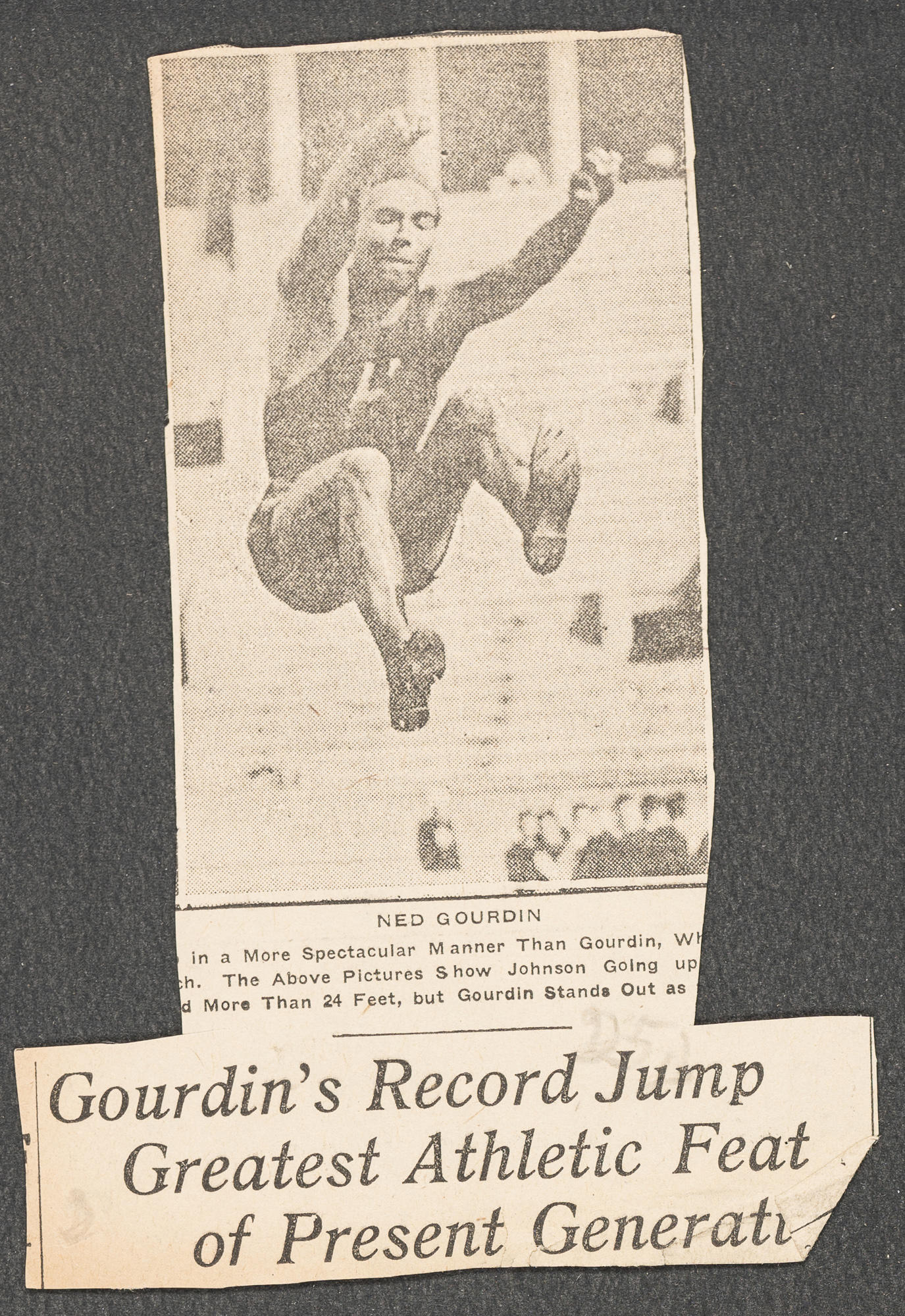Isabella Stewart Gardner kept comprehensive guest books where she recorded her visitors and noted current events by pasting in articles from local newspapers.

Cover of Isabella Stewart Gardner’s Guest Book, Volume III, 31 May 1896–2 September 1897 (v.1.b.4.14)
The guest books, now in the Museum Archives, used to be kept in the Vatichino, a small recently-restored space that Isabella treated as a sort of storage place for many objects. In 1921, she read and saved several articles about Edward Orval Gourdin (1897–1966).

“Gourdin Shows How He Made World Record Broad Jump,” Boston Sunday Post, 31 July 1921
Newspaper clipping from Isabella Stewart Gardner’s Guest Book, Volume XV (v.1.b.4.26)
Born in Jacksonville, Florida, Gourdin was a Black and Native American (Seminole) man who attended Harvard and distinguished himself as a scholar and athlete. Ned, as he was known, became a champion sprinter, pentathlete, and long jumper. Isabella clipped articles about Gourdin’s world-record-setting long jump at a 1921 college track meet where he became the first person to jump further than 25 feet in an official competition.*

“Gourdin’s Record Jump Greatest Athletic Feat of Present Generation,” 1921. Newspaper clipping from Isabella Stewart Gardner’s Guest Book, Volume XV (v.1.b.4.26).
Gourdin completed both his undergraduate and law degrees at Harvard, demonstrating a dedication to balancing his talents both on and off the field. Shortly after finishing his final-year law exams, he traveled to Paris for the 1924 Olympics and won a silver medal for the long jump—a remarkable feat for anyone, let alone a law student who worked as a postal worker to support himself financially!^
And if all of this were not impressive enough, he went on to become a distinguished lawyer. Settling in Roxbury, he was appointed an Assistant United States Attorney for Massachusetts under the administration of President Franklin D. Roosevelt. He served in that role for almost 20 years, only taking leave to fight in World War II. A member of the National Guard since 1925, Gourdin was a commanding officer with the 372nd Infantry Division, composed mainly of Black enlisted men and white officers.

Ned Gourdin and fellow soldier “Harry” at Bonnie Blink, Arizona, December 1944
Photo courtesy of the Edward Gourdin Collection, Howard Gotlieb Archival Research Center, Boston University
He chafed against racism in the still-segregated U.S. Army. His papers are preserved in the Special Collections at Boston University library, and one 1945 diary entry reads: “We have been plagued for 5 years with newcomers (reserve officers and grads of OCS [Officer Candidate School]) who seem to assume that Negro soldiers do not know anything.”†
Continuing to break barriers, Gourdin became the first person of color appointed as a judge on the Roxbury District Court in 1951 and then in 1958 was the first person of color named to the Massachusetts Superior Court.
![Governor Paul Dever, Representative Thomas H. [illegible], Judge Edward O. Gourdin, and Representative Vincent F. Cronin, identified as showing, left to right, undated. Photo courtesy of the Edward Gourdin Collection, Howard Gotlieb Archival Research Center, Boston University.](https://www.gardnermuseum.org/sites/default/files/styles/portrait_large/public/2020-08/Ned_Gourdin_Unknown_4820x5954.jpg)
Governor Paul Dever, Representative Thomas H. [illegible], Judge Edward O. Gourdin, and Representative Vincent F. Cronin, identified as showing, left to right, undated
Photo courtesy of the Edward Gourdin Collection, Howard Gotlieb Archival Research Center, Boston University
According to his son—also an accomplished runner—Gourdin stayed fit as a fiddle even into old age. Edward Jr. told a Boston University magazine, “I remember kidding around with him one day in 1960 about racing him. He was 62 or 63 at the time, and I was in my mid-20s. We had a dirt road beside our house, probably 150 yards long, and we raced for real. I took off and got a lead on him for the first 25 yards before he whistled by me like I was standing still. I was shocked. He was still fast.”+
The rich archives at the Isabella Stewart Gardner Museum not only provide insight into the stories of Isabella and her immediate friends, but they also shed light on the lives of a wide range of people whose achievements she observed and admired. Gourdin never signed the guestbook, and likely did not visit the Museum during Isabella’s lifetime—by the time he set his record in 1921, Isabella had already had a stroke, which severely limited her social interactions. However, her clipping these articles shows she noticed and appreciated his accomplishments.
Like Isabella, Ned Gourdin was an exceptional Bostonian. In 2010, to commemorate his many accomplishments, a Roxbury park was named after him and dedicated to African-American veterans: the Justice Edward O. Gourdin Veterans Memorial Park.
*Amy Dean, “Edward Gourdin: Olympic silver medalist, but a man of firsts,” Boston University Bridge, Volume 5, Number 23, February 15, 2002. URL: http://www.bu.edu/bridge/archive/2002/02-15/connect.htm
^Dean, "Edward Gourdin"
†Quoted in Daphne Abeel, “Edward Orval Gourdin, Brief life of a breaker of barriers: 1897-1966,” Harvard Magazine, Fall 1997. URL: https://harvardmagazine.com/1997/11/vita.html
+Quoted in Amy Dean, “Edward Gourdin: Olympic silver medalist, but a man of firsts,” Boston University Bridge, Volume 5, Number 23, February 15, 2002. URL: http://www.bu.edu/bridge/archive/2002/02-15/connect.htm